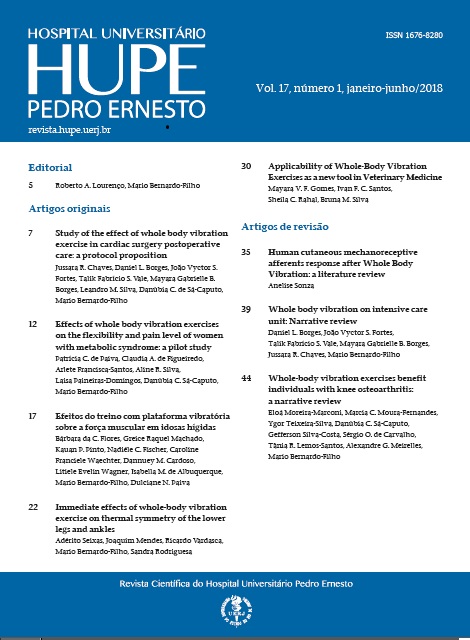Immediate effects of whole-body vibration exercise on thermal symmetry of the lower legs and ankles
DOI:
https://doi.org/10.12957/rhupe.2018.39272Abstract
Introduction: Whole-body vibration exercise (WBV) has
become an alternate modality of exercise for rehabilitation.
Few studies have addressed the effect of this exercise modality
using skin temperature as an outcome measure and fewer
have studied the effect of whole-body vibration on thermal
symmetry. The aim of this study is to evaluate the impact of
acute exposure to vibration exercise on thermal symmetry
of the lower legs in healthy subjects.
Methods: Skin temperature of 36 healthy and non-trained
male and female subjects was recorded using thermography
(FLIR A325sc camera), before and after the exposure to vibration
exercise or control setting. All subjects were instructed
to undress and remain still in the examination room for 15
minutes to achieve thermal stabilization. The room temperature
and relative humidity were controlled, with absence of
air flow. The Power Plate® provided mechanical stimulation
with parameters set at a frequency of 35Hz, high amplitude
(5-6mm), resulting in maximum acceleration of 121-145 m/
s2, for 5 minutes.
Results: Thermal symmetry was higher in the anterior aspect
of the lower leg (0.17±0.13ºC) and lower in the lateral aspect of
the ankle (0.27±0.20ºC). The acute bout of exposure to WBV
significantly affected thermal symmetry in both ankles, anterior
and lateral aspects (p≤0.05).
Discussion: The results suggest that the exposure to an acute
bout of vibration exercise (35Hz) influences thermal symmetry
of the ankles, though the mechanism underlying these
changes will require future studies to be fully understood
either in healthy and patient subjects.
Keywords: Skin temperature; Thermography; Vibration.
References
Mansfield NJ. Human Response to Vibration. United States of
America: CRC Press; 2005.
Rittweger J. Vibration as an exercise modality: how it may
v. 17, n. 1, jan-jun/2018 29
work, and what its potential might be. Eur J Appl Physiol.
;108:877–904.
Cochrane DJ. Vibration Exercise: The Potential Benefits. Int J
Sports Med. 2011;32(02):75-99.
Cardinale M, Bosco C. The Use of Vibration as an Exercise Intervention.
Exercise and Sport Sciences Reviews. 2003;31(1):3-7.
Lohman EB, Petrofsky JS, Maloney-Hinds C, et al. The effect
of whole body vibration on lower extremity skin blood flow
in normal subjects. Med Sci Mon Int Med J Exp Clin Res.
;13(2):CR71-6.
Kerschan-Schindl K, Grampp S, Henk C, et al. Whole-body
vibration exercise leads to alterations in muscle blood volume.
Clin Physiol. 2001;21(3):377-82.
Brengelmann G, Johnson J, Hermansen L, et al. Altered control
of skin blood flow during exercise at high internal temperatures.
J Appl Physiol (1985). 1977;43(5):790-4.
Charkoudian N. Skin blood flow in adult human thermoregulation:
how it works, when it does not, and why. Mayo Clinic
Proceedings. 2003;78(5):603-12.
Pascoe DD, MErcer J, Weerd Kd. Physiology of Thermal
Signals. In: Diakides M, Bronzino JD, PEterson DR, editors.
Medical Infrared Imaging - Prionciples and Practices. Boca
Raton FL: CRC Press; 2013. p. 6.1-6.20.
Burnham RS, McKinley RS, Vincent DD. Three types of
skin-surface thermometers: a comparison of reliability, validity,
and responsiveness. Am J Phys Med Rehabil. 2006;85(7):553-
Ring EFJ, Ammer K. Infrared thermal imaging in medicine.
Physiological measurement. 2012;33(3):R33-46.
Vardasca R, Ring EFJ, Plassmann P, et al. Thermal symmetry of
the upper and lower extremities in healthy subjects. Thermology
International. 2012;22(2):53-60.
Fernández-Cuevas I, Sillero-Quintana M, Garcia-Concepcion
MA, et al. Monitoring skin thermal response to training with
infrared thermography. New Stud Athl. 2014;29(1):57-71.
Cochrane DJ, Stannard SR, Sargeant AJ, et al. The rate of
muscle temperature increase during acute whole-body vibration
exercise. Eur J Appl Physiol. 2008;103(4):441-8.
Gold JE, Cherniack M, Hanlon A, Soller B. Skin temperature
and muscle blood volume changes in the hand after typing. Int
J Ind Ergon. 2010;40(2):161-4.
Games KE, Sefton JM. Whole-body vibration influences lower
extremity circulatory and neurological function. Scand J Med
Sci Sports. 2011;23(4):516-23.
Seixas A, Silva A, Gabriel J, et al. The Effect of Whole-body Vibration
in the Skin Temperature of Lower Extremities in Healthy
Subjects. Thermology International. 2012;23(12):59-66.
Seixas A, Vardasca R, Gabriel J, editors. The effect of different
vibration frequencies in the skin temperature in healthy subjects.
IEEE International Symposium on Medical Measurements
and Applications (MeMeA); 2014: IEEE.
Sonza A, Robinson CC, Achaval M, et al. Whole body vibration
at different exposure frequencies: infrared thermography and
physiological effects. The Scientific World Journal. 2015;2015.
Ammer K. The Glamorgan Protocol for recording and evaluation
of thermal images of the human body. Thermology international.
;18(4):125-44.
Schwartz RG. Guidelines For Neuromusculoskeletal Thermography.
Thermology International. 2006;16(1):5-9.
Moreira DG, Costello JT, Brito CJ, et al. Thermographic
imaging in sports and exercise medicine: A Delphi study and
consensus statement on the measurement of human skin
temperature. J Therm Biol. 2017;69:155-62.
Manimmanakorn N, Hamlin MJ, Ross JJ, et al. Long-term
effect of whole body vibration training on jump height: meta-
analysis. J Strength Cond Res. 2014;28(6):1739-50.
Tomczak M, Tomczak E. The need to report effect size estimates
revisited. An overview of some recommended measures
of effect size. Trends in Sport Sciences. 2014;21(1):19-25.
Bland JM, Altman DG. Statistical methods for assessing agreement
between two methods of clinical measurement. Lancet.
;327(8476):307-10.
Faul F, Erdfelder E, Lang A-G, et al. G*Power 3: A flexible statistical
power analysis program for the social, behavioral, and
biomedical sciences. Behav Res Methods. 2007;39(2):175-91.
Cohen J. Statistical Power Analysis for the Behavioral Sciences.
United States of America: Lawrence Erlbaum Associates; 1988.
Hazell TJ, Thomas GWR, DeGuire JR, et al. Vertical wholebody
vibration does not increase cardiovascular stress to static
semi-squat exercise. Eur J Appl Physiol. 2008;104(5):903-8.
Cochrane DJ, Stannard SR, Firth EC, et al. Comparing muscle
temperature during static and dynamic squatting with and
without whole body vibration. Clin Physiol Funct Imaging.
;30(4):223-9.
Roelants M, Verschueren SM, Delecluse C, et al.
Whole-body-vibration-induced increase in leg muscle activity
during different squat exercises. J Strength Cond Res.
;20(1):124-9.


